July 20, 2022
Given the many books on the forced removal and incarceration of Japanese Americans during World War II aimed at teenage audiences, it is a bit surprising that there are relatively few books on this topic aimed at younger children, in particular children’s picture books. But with the recent publication of Love in the Library by Maggie Tokuda-Hall and illustrated by Yas Imamura—this seems like a good opportunity to take another look at this small but significant body of work.
By my count, there are fourteen children’s picture books that are set at least in part in one of the concentration camps that held Japanese Americans during World War II. These are relatively short books aimed at elementary school children that consist of illustrations that often span two pages, accompanied by short text. (Think Where the Wild Things Are.) Given the somewhat challenging subject matter, there aren’t any “camp” books for a pre-K audience — think Goodnight Moon — that I know of.
Here is a quick rundown of the fourteen, based on what period of the WWII incarceration experience they cover:
Forced Removal and Arrivals in Camp
The Bracelet (1993)
Story by Yoshiko Uchida, illustrated by Joanna Yardley
Philomel Books
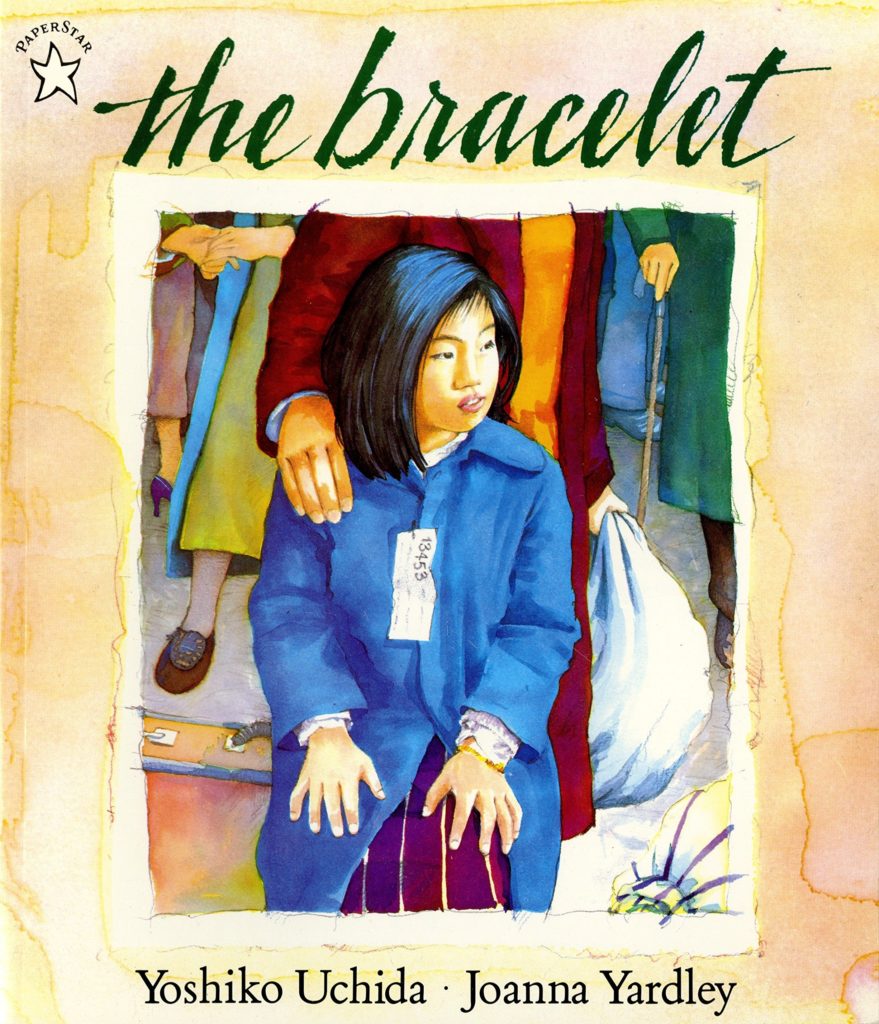
The protagonist is young Emi, who is sad as she, older sister Reiko, and her mother prepare for removal from their Berkeley home in the spring of 1942, her father having already been arrested and interned elsewhere. Laurie Madison, her best friend, stops by just before with the gift of a bracelet. They then gather for removal to Tanforan and their horse stall home. But somewhere in the moving, she loses the bracelet. Good depiction of removal and incarceration and a nice message/story. Yardley’s watercolor illustrations are colorful and realistic, though are perhaps not as eye-catching as those in many of the other books on this list.
Children’s Lives in the Camps
Baseball Saved Us (1993)
Written by Ken Mochizuki, illustrated by Dom Lee
Lee & Low Books, Inc.
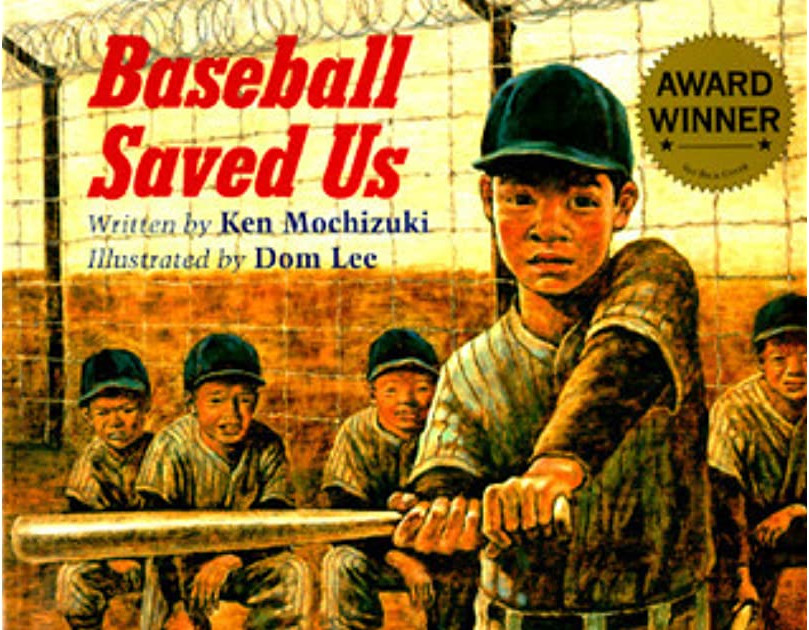
Written in the first-person from the perspective of a young boy in an unspecified camp with his family, the story centers on the redeeming power of baseball in a concentration camp context. The lessons the protagonist learns from baseball in camp follow him to his postwar life. Though some readers objected to the title and thought the idea of baseball as salvation was overstated, the book does make it clear that camp and postwar life were miserable. As with many fictional accounts, the book also makes it seem like baseball was entirely run by the inmates, as there is no mention of the War Relocation Authority, the only white character being an unnamed soldier in a guard tower. But the book does a good job of balancing its somewhat hopeful story with details on camp life and the injustice of it all. Lee’s illustrations are realistic and painterly.
Blue Jay in the Desert (1993)
Written by Marlene Shigekawa, illustrated by Isao Kikuchi
Polychrome Publishing Company
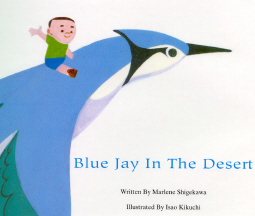
Junior is a young boy in Poston with his family. His grandfather, a talented wood carver, is making a piece for Junior, a blue jay. Junior is at first disappointed that it is not a more majestic animal, but after learning more about blue jays, comes to realize its appropriateness to his situation. The story also includes a tangential interlude involving some Mohave gifting the inmates corn seed for their gardens. Kikuchi’s bold, blocky drawings cover entire pages and include lots of guard towers and barbed wire.
A Place Where Sunflowers Grow (2006)
Story by Amy Lee-Tai, Illustrated by Felicia Hoshino
Children’s Book Press

The granddaughter of artists Matsusaburo Hibi and Hisako Hibi, Lee-Tai authors a gentle tale about Mari, a young girl at Topaz based on her mother, who misses her old home, while struggling to draw anything at the Topaz Art School. As with Flowers from Mariko, gardening—in this case, planting sunflower seeds—provides solace and hope. Felicia Hoshino’s muted illustrations of watercolor, ink, tissue paper, and acrylic stretch across both pages with text inserted in various places. In a nice touch, some are based on images by Hisako Hibi. Unique among these books in that the text is in both English and Japanese.
Hello Maggie! (2007)
By Shigeru Yabu, illustrated by Willie Ito
Yabitoon Books

Unique among these books in that it was both written and illustrated by former inmates, this is Yabu’s autobiographical story of confinement as a ten-year-old and his adoption of a pet magpie named Maggie while at Heart Mountain. Ito’s cute, cartoon-like illustrations make Maggie come alive. Unlike most of the other books, this one doesn’t go out of its way to note poor conditions at the camp.
Barbed Wire Baseball (2013)
Written by Marissa Moss, illustrated by Yuko Shimizu
Abrams Books for Young Readers
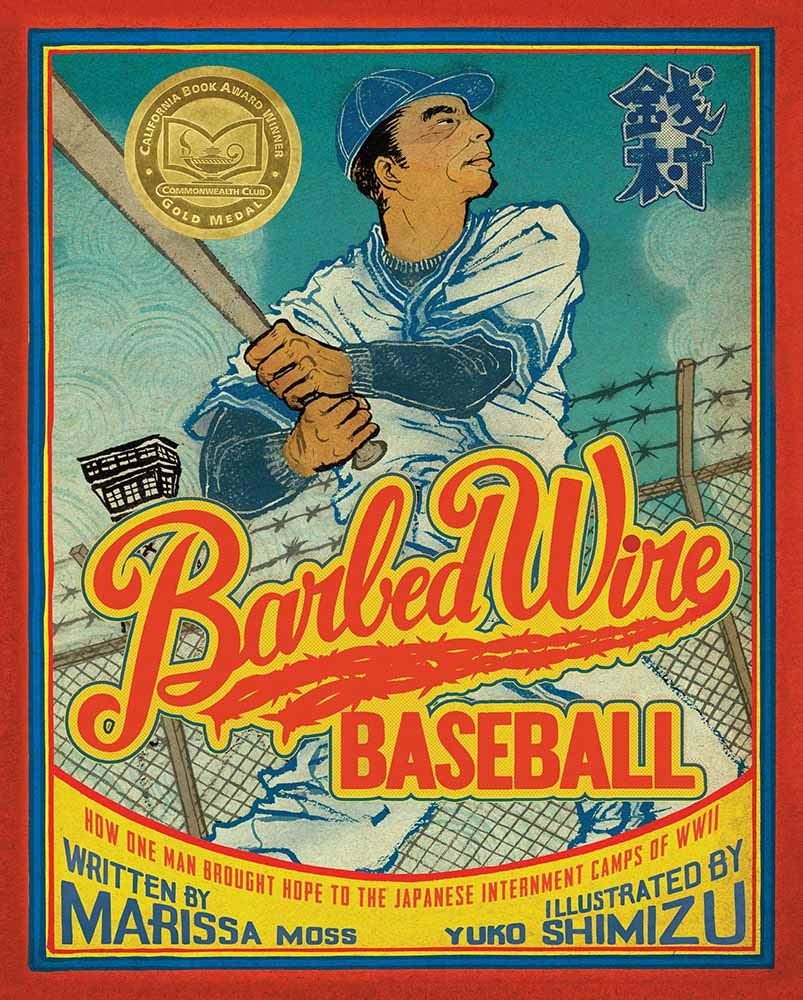
Beautifully illustrated story of Kenichi Zenimura and his quest to build a baseball field at Gila River. The story sort of mirrors Baseball Saved Us, while probably also overstating both the impact of baseball and the extent of inmate efforts. Includes a useful Afterword, and Author’s and Artist’s Notes, photos, Bibliography, and Index. Shimizu’s illustrations, “made with Japanese calligraphy brush and ink on TH Saunders Waterford paper” are among the most striking visually of any of the books.
Fish for Jimmy: Inspired by One Family’s Experience in a Japanese American Internment Camp (2013)
Written and illustrated by Katie Yamasaki
Holiday House
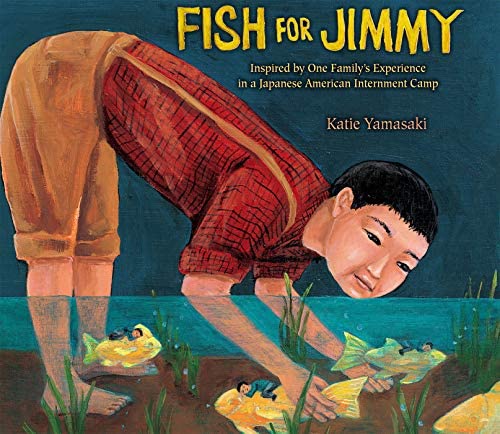
Touching story of two brothers, Taro and Jimmy, who are sent to an unspecified camp at which younger brother Jimmy stops eating, recalling the fresh fish he would eat before the war. As Jimmy gets weaker, Taro sneaks out of camp to try to catch fish for him. Fish for Jimmy does a good job with setting the scene: the happy family running a produce stand before the war, the father getting arrested and interned, the roundup and imprisonment. In a letter to the reader, the artist/author tells us that the story is based on something that really happened in her family history at Amache. Illustrations are full two-page spreads of what appear to be oil paintings that incorporate both realistic and dreamlike imagery.
Love in the Library (2022)
By Maggie Tokuda-Hall, illustrated by Yas Imamura
Candlewick Press
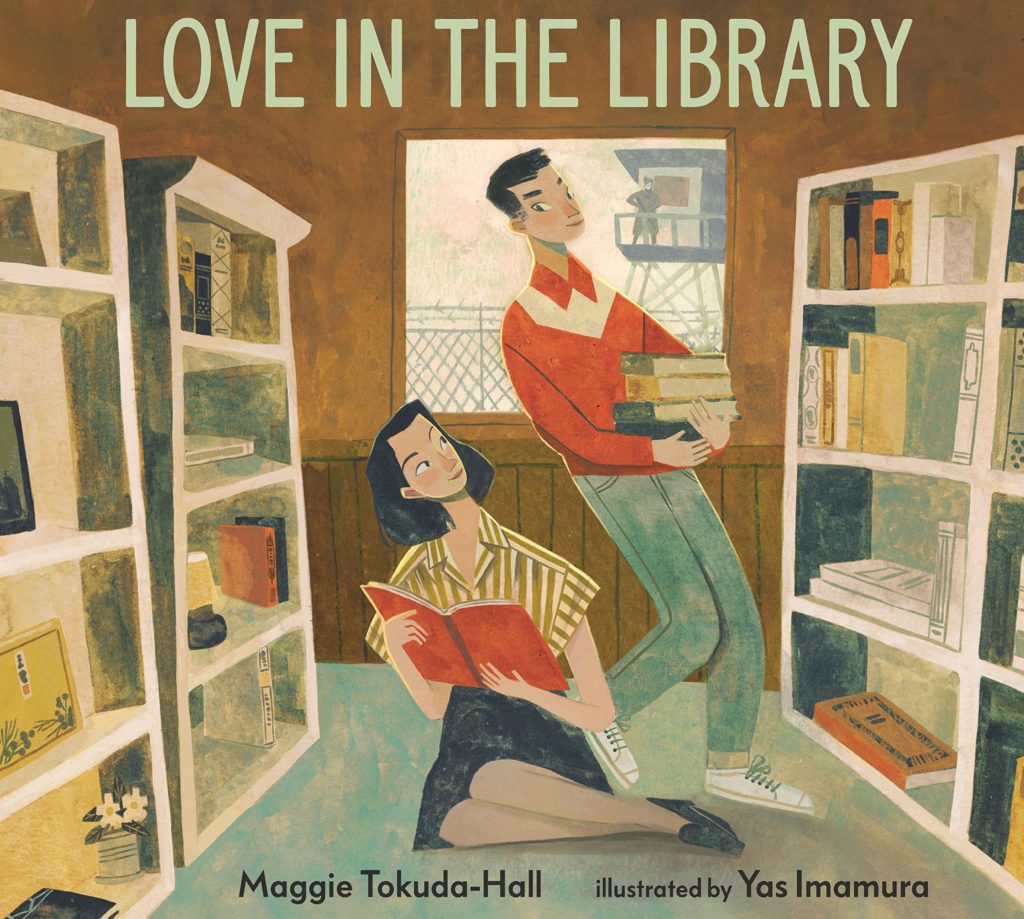
Like many of the other books, this is a story of inmates overcoming the deprivations of concentration camp life, in this case in the form of a love story. Protagonist Tama is a librarian at Minidoka who is initially puzzled at constant patron George, who seems to check out more books than he can possibly read, until she realizes that the books might not be the only thing he is interested in. The story is based on the author’s grandparents’ camp story, and is a not uncommon one among Nisei of a certain age. Imamura’s gouache and watercolor illustrations look great, but convey some inaccurate views of the camp, for instance situating the library by itself literally against the barbed wire fence (the main community library in Minidoka was the Block 23 recreation hall, which was more-or-less right in the middle of the camp) and having guard towers and armed soldiers seemingly everywhere. On the other hand, as the newest book on the list, this is the only one that uses current non-euphemistic terminology.
Friends and Allies
Write to Me: Letters from Japanese American Children to the Librarian They Left Behind (2018)
By Cynthia Grady, illustrated by Amiko Hirao
Charlesbridge
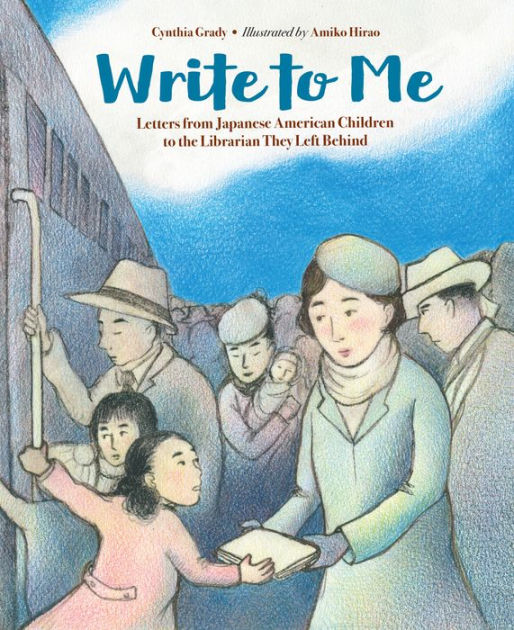
Straightforward telling of Clara Breed’s oft-told story. A children’s librarian in San Diego, Breed corresponded with dozens of Japanese American children she had come to know at her library while they were incarcerated at the Poston, Arizona, camp. Grady quotes from many of the letters the children wrote back to Breed. Includes more supplementary materials than any of the other books on this list: Author’s Note on Breed, Notable Dates in Clara Breed’s Life, Selected History of Japanese People in the United States, Source Notes, Selected Bibliography, and Further Reading. Colored pencil illustrations by Hirao are effective, but don’t stand out among others.
Resettlement and the Return to the West Coast
Flowers from Mariko (2001)
By Rick Noguchi and Deneen Jenks, illustrated by Michelle Reiko Kumata
Lee & Low Books, Inc.

This one is largely set after camp, beginning as protagonist Mariko gets ready to leave an unspecified camp (though cactus suggests one of the Arizona ones) with her parents and little sister Emi to return home to California. They hit a bump in the road when Mariko’s father returns to get his gardening truck only to find it and the landlord he had entrusted with it gone. They end up in a trailer camp, the father jobless, the situation desperate. Mariko’s flower garden at the trailer camp provides a small sliver of hope. The post-camp focus and trailer camp setting coincide with my interests, and the story is a moving one. The illustrations by Michelle Reiko Kumata are among my favorites in this group, with her use of scanned period fabrics and papers creates a striking effect.
Welcome Home Swallows (2001)
Written by Marlene Shigekawa, illustrated by Isao Kikuchi
Heian International, Inc.

A sequel to Blue Jay in the Desert that also involves birds, this one finds Junior now returning to California after camp and finding both friendship and conflict at school. A field trip to San Juan Capistrano results in a school assignment to draw pictures of someone they want to return, bringing in the story of two of Junior’s uncles, one a veteran of the 442nd Regimental Combat Team, the other a renunciant from Tule Lake. Kikuchi’s illustrations are colorful but simpler than in the earlier book and have a bit of a retro, Gyo Fujikawa-like quality to them.
The Legacy of WWII Incarceration
So Far from the Sea (1998)
By Eve Bunting, illustrated by Chris K. Soentpiet
Clarion Books

Set in 1972, seven-year-old Laura visits the Manzanar site with her younger brother and parents for the last time in a while, since the family will soon be moving to Boston. At the site, they visit the grave of her grandfather, while flashback scenes take us back to 1942. The only one of these books set in a post-camp past—this is a common strategy in adult novels about camp, e.g. Farewell to Manzanar (I know it is not a novel, but it is certainly novel-like), Hotel on the Corner of Bitter and Sweet, and Southland—it is doubly evocative for both 1942 and 1972. Chris K. Soentpiet’s watercolor illustrations—1972 images in muted color, historic images in grays—are striking, large and realistic, even if the family somehow doesn’t quite look Japanese.
Home of the Brave (2002)
Written and illustrated by Allen Say
Houghton Mifflin Company

Acclaimed artist and children’s book writer/illustrator Say comes up with an almost surrealist story here of a man in a kayak who plunges down a rapid into a dream state in which he encounters tagged Japanese American children in and out of a concentration camp along with other children on an Indian reservation. Little explanation is provided as to what we are seeing, so it would be up to parents to explain the context. An odd and nightmarish storyline for this age group. Say’s watercolor illustrations are striking as usual. Say was inspired to write the book by an exhibition at the Japanese American National Museum that he saw while his own retrospective exhibition was on display there.
The Cat Who Chose to Dream (2014)
Written by Loriene Honda featuring artwork by Jimmy Tsutomu Mirikitani, foreword by George Takei
Martin Pearl Publishing

Unusual book written by a psychotherapist that is largely about the psychological impact of the incarceration and coping with it through the eyes of a cat named Jimmy, who is incarcerated along with his Japanese American family. Jimmy recalls his feelings of “anger, frustration, shame and sadness” and how he copes by imagining happier scenes. The art is adapted from existing drawings and paintings by former inmate artist Jimmy Mirikitani. Includes “Ideas for Discussion” afterwards, along with a page on “The Incarceration of Japanese Americans During World War II” and one on “The Art of Jimmy Tsutomu Mirikitani,” along with a gallery of the unmodified paintings that were used to illustrate the book.
Readers might also be interested in a couple others aimed at slightly older audiences, including The Journey by Sheila Hamanaka and It Began with a Page by Kyo Maclear.
While I have strong favorites among young adult books on the incarceration, I didn’t have the same reaction with these books for younger children. I didn’t love or hate any of them in particular. I think this has to do with the fact that authors of books for this age group just can’t go as deep on the core issues of injustice, racism, scapegoating, and the like, and so there is less history to get wrong. All of them are worthwhile for the right child, and for parents and children alike, the right book from this list will have more to do with interest in a particular subject matter (e.g. baseball, animals, libraries), identification with the age and gender of the protagonist, and the appeal of the illustrations than anything else.
Of the fourteen books, twelve are by Japanese American authors and all but one have Asian American illustrators. This is quite different from books for older children, where most are written by professional children’s book authors who don’t have specific knowledge of the history. About half are based on true stories, and protagonists are more-or-less equally divided between boys and girls (five of the former, four of the latter) and others (adults, non-Japanese Americans, and animals). Perhaps reflecting both the time in which they were written and the young audience, all but the latest book use terminology that most would consider euphemistic. Also reflecting larger trends, the later books include much more supplemental information on the history, origin of the story, and illustrations, something that is almost always a good thing.
So if you have a child of the appropriate age in your life whom you want to introduce to the incarceration story, you have many good choices. As interest in this topic continues to grow, I anticipate we will see many more books for this age group in the coming years.
—
By Brian Niiya, Densho Content Director
[Header: Children reading a book at table, February 12, 1944. Courtesy of Yoshio Okumoto.]

